This post originally appeared on Murder Is Everywhere.
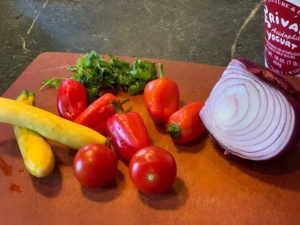
A little more than a week ago, I was lying in a darkened bedroom at 4 PM on a Friday afternoon—wracked with fatigue, weakness and thirst.
The day had started splendidly. I’d driven about 40 miles to the Washington suburbs to visit with my new author friend Shauna Singh Baldwin, a Wisconsin-based writer who was visiting a school friend who lived there. Shauna had been chatting with me the night before about my new book. It was cool at 8:30, when we walked—Shauna, her friend Ruma, and me. I wore a hat, sunscreen and sunglasses and took a sun protection supplement. Oh, yes—the top below is my favorite 50 SPF rash guard. I have to take extra precautions due to medication-induced sun sensitivity. I’m on Shauna’s left.

Because I was making this drive, an opportunity rose in my mind for GOOD FOOD. Specifically, South Indian food. In Baltimore, the South Asian diaspora is mostly represented North Indian and Nepali restaurants. The Washington, DC, suburbs have more diverse cuisines. I’d been longing for a dish called uthappam, a pancake of fermented rice and lentil flours that’s studded with tiny bits of vegetables and chillies. Next to dosa, uthappam is one of South India’s most popular exports, served all around India. There’s a special magic to its fermented sour taste. If you’ve tasted dosa, you’ll recognize uthappam as a less glamorous, heartier cousin.
The picture below is how Wikipedia defines uthappam.
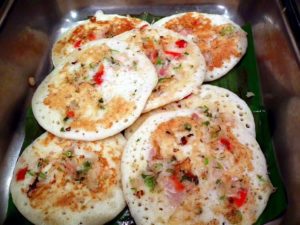
The ladies and I had a glorious time on the walk through shady neighborhood streets. I told Shauna’s friend, Ruma, about my desire for uthappam. To save time, Ruma recommended that I save time by foregoing the restaurant I’d planned to drive to in Gaithersburg. She was a fan of a restaurant called Chettinadu in Rockville, a suburb near Bethesda.
I said goodbye to my friends, applied more sunscreen, and took off. Due to roadwork and closed lanes, the drive through suburban streets to Rockville took as long as my earlier drive from Baltimore to Bethesda. This translated to about 40 minutes of one-way driving, with the mid-morning sun blazing through my windshield. I felt it. had the brim of my hat pulled low and sunglasses on and a surgical mask covering my lower face. As the sunlight intensified, and the car moved along at ten miles and hour, I thought to myself, I’m doing all of this for a spicy pancake?
Chettinadu’s storefront marquee was at the back of a large shopping center parking lot. I’ve come to take this as an auspicious sign, when it comes to small international restaurants. I exited my car under a cloudless sky and walked a couple of agonizing, overheated minutes to the restaurant. Still fully shielded by hat, mask and dark glasses, I slunk into the restaurant like a too-obvious spy and sat down to wait for my order to finish cooking. You see, in addition to uthappam, I’d ordered a plain pancake known as appam, a mixed vegetable curry, a chicken curry, vadas, and rasam.
The sun didn’t give me a break on the ride home, and I didn’t feel well when I got inside. I drank more water, ate a little vegetable curry and ate a quarter of the uthappam. Then I toppled into bed. I felt strange. It’s hard to explain, but I was thirsty, and very, very tired, in a way that didn’t feel restful, though I did fall asleep.
Fortunately, it was not actual sunstroke, in which I might have sprung a temperature. This sun exhaustion was almost surely caused by a drug reaction, I learned as I looked at the profiles of two meds I’d taken the day before my car trip. I was so much better the next morning and attacked the uthappam again at breakfast and lunch. I didn’t have any left the day after, and I wanted more.
But not that drive.
I told myself that if I could make my own uthappam. Many uthappam recipes are in South Indian cookbooks and online. There also are myriad websites where Indian home cooks are sharing healthier versions of classic recipes.
I was more confident than wise.
I attempted a classic uthappam batter, which ferments up to 20 hours and is made with soaked urad dal and parboiled rice. Both ingredients soften in water for 6 hours and are then ground together with their soaking water into a batter. The batter then ferments from eight to twenty hours.
It turned out that my air-conditioned house is too cold for this batter to ferment, and my screened porch simply too hot to do anything except grow blue and yellow bacteria spots on the surface. For this kind of cooking, you need a mother, aunty, or South Indian chef looking over your shoulder.
It wasn’t time to quit. I could attempt one of the new, instant uthappam recipes from the armies of Indian food bloggers. They are instant in the sense that they use a little yogurt or baking soda to get the batter bubbly. Here are the ingredients before mixing and the finished batter below.
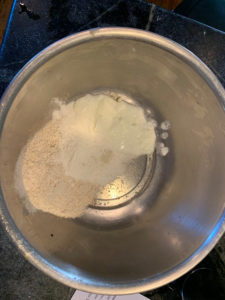
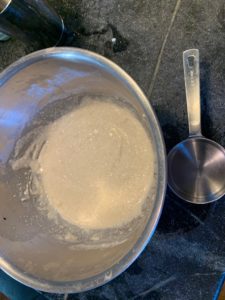
I defaulted to easy by picking a recipe calling for ingredients that were already in my house. Indians are increasingly health conscious and making changes to traditional dishes. Several uthappam recipes using oats as the main flour caught my eye. I decided to try “oatmeal uthappam,” in which rolled oats are ground into a kind of flour or left whole if they are instant oats. The batter doesn’t ferment overnight like classic recipes, but it has a good bacteria boost from probiotic plain yogurt.
The pancake was quite thick, as the recipe author warned, and it took three tries till I could get it to semi-uthappam shape—although it was uneven. Quickly I discovered less is more with the vegetables toppings, and given the fibrous quality of oatmeal, water must be added to make the batter suitably thin. Spreading the batter had to be fast and the vegetables needed to scatter within the next 30 seconds and be gently pressed down. I arranged everything right next to the frying pan and worked as fast as I could.

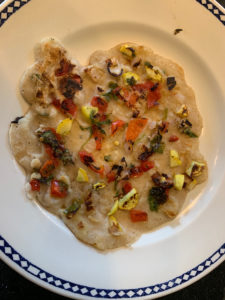
In India, uthappam are fried on a tawa, which looks like a large round frying pan, typically cast iron or aluminum. I found cast iron worked better for me than stainless.
Broken pancakes would never be served at Chettinadu, but they were at my house. And there was a pleasant tang. I at the second pancake, because the first was an utter ruin, and by the third pancake, I had one that flipped out of the pan and into the plate without breaking. Although it still wasn’t round.
In a way, making these pancakes was a lot like trying to write a book. My pages are a mess at first—I’ve just got to keep returning to the work and learning my way through the story. With practice, we inevitably get the skills.
I judged my uttapam a 6 out of 10, and my husband gave it a 9.
So the third one was better!
Here’s the recipe I tried by food blogger Swasthi from Indian Healthy Recipes.
